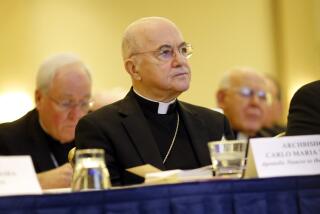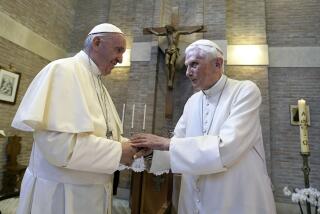The Vatican’s Secret Memo on Galileo : GALILEO: Heretic<i> by Pietro Redondi; translated by Raymond Rosenthal (Princeton University: $29.95; 356 pp., illustrated) </i>
- Share via
Galileo Galilei seems destined to be an unending source of controversy. In his lifetime (1564-1642), his advocacy of the Copernican system in astronomy and of a new approach in physics brought him into direct and bitter conflict with the defenders of the status quo. Aristotelian philosophers, then the dominant force in academia, foresaw correctly that Galileo’s doctrines were a death threat to their entire cosmology. Catholic theologians, still on full alert against further encroachments by the Protestant Reformation, took umbrage at Galileo’s insistence on the need to reinterpret certain Scriptural passages that seemed to favor a geocentric universe.
Galileo was a forceful personality, as headstrong as he was brilliant, and he had almost as many defenders and disciples as he did detractors and determined enemies. After a warning from the Holy Office in 1616 that Copernicanism was false and contrary to Scripture and that it was not to be taught or held as factual or as reconcilable with Scripture, Galileo spent the next 16 years adducing scientific evidence that he hoped would win the day.
Historian Pietro Redondi’s work “Galileo: Heretic,” first published in Italy in 1983 and rendered in an absolutely masterful translation by Raymond Rosenthal, challenges the commonly accepted version of Galileo’s trial and argues for the startling thesis that the condemnation of Galileo had nothing to do with astronomy and Scripture.
In the style of a detective story, Redondi describes how he uncovered a heretofore unknown document secreted in the files of the Holy Office and how this set him on the track of a wholly new explanation of why the churchmen had to censure and silence Galileo. The document was an unsigned denunciation to the Holy Office of Galileo’s work, “The Assayer,” published in 1623. The complaint called attention to the incompatibility between Galileo’s atomism and the demands of Eucharistic theology. If consecrated bread is the body of Christ, how is it that the Host still looks, feels, smells and tastes like bread? The Scholastic theory of substance and accidents was used by the Council of Trent to express the mystery. But atomism seemed to allow for no such subtlety.
In light of this document Redondi circles back and retells the entire story of Galileo’s conflict with the theologians, focusing on Eucharistic doctrine and not the literal sense of Scripture as the real battle line. He argues that it was the Jesuits who really wanted to see Galileo done in--partly out of personal animosity, largely to defend the Scholastic philosophy of matter and form, and mainly to protect Pope Urban VIII from becoming too tolerant of Galileo and risking association with heresy.
Unfortunately, Redondi builds his case while ignoring substantial evidence that supports the version accepted by most historians of the affair. It is no doubt true that the anti-Galileo faction was not happy to see him on the ascendancy when his friend Maffeo Barberini became Pope Urban VIII in 1623. Indeed, the new Pope allowed Galileo’s book “The Assayer” to be dedicated to him even though it was an all-out attack on a noted Jesuit astronomer named Horatio Grassi.
But it is also true that the Pope refused to revoke the prohibition of 1616 against Copernicanism and that he urged Galileo to be prudent and to argue only hypothetically for his views. But Galileo expressly set out to prove the heliocentric system no matter what. His “Dialogue on the Great World Systems,” published in 1630, tried to do just that--and failed. To make matters worse, Galileo had put Pope Urban’s thoughts in the mouth of the laughing stock of the “Dialogue.” Urban was convinced that Galileo intended to mock him. At that point, papal protection was withdrawn, and Galileo was left to the mercies of an ill-disposed tribunal that seemed more intent on personal revenge than on doctrinal purity. Years later, Galileo himself confirmed this: “I hear from Rome that Cardinal Antonio and the French Ambassador have spoken to His Holiness and attempted to convince him that I never had any intention of committing so sacrilegious an act as to make fun of His Holiness, as my malicious foes have persuaded him and which was the major cause of all my troubles” (“Opere” XVI, 455).
One can understand the author’s excitement at discovering some new evidence, and it does appear that some theologians at least were trying to discredit Galileo in any way they could. But it is a long way from that point to proving that an unsigned and secret denunciation on grounds wholly unrelated to his trial was the real crux of Galileo’s condemnation. Still, Redondi’s prodigious research has filled in many gaps in our knowledge of the Galileo story. That is an achievement well worth noticing by anyone interested in the forces and figures that attended the birth of the modern world.
More to Read
Sign up for Essential California
The most important California stories and recommendations in your inbox every morning.
You may occasionally receive promotional content from the Los Angeles Times.













